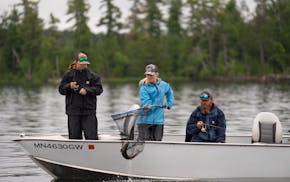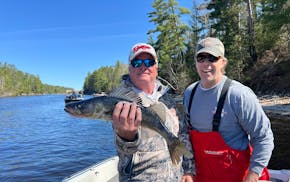In a few weeks, some 200 Minnesota birders will flock to the Salt Lake Wildlife Management Area (WMA) in Lac qui Parle County near the South Dakota border.
This will be the 47th celebration of Minnesota's oldest birding festival, and this year's hosts will include the Minnesota Ornithologists' Union, the Minnesota River Valley Audubon Chapter and others.
Attending birders will be shuttled by bus to Salt Lake WMA and other nearby WMAs, and likely will peer through binoculars and spotting scopes to see tundra and trumpeter swans, red-necked phalaropes and various species of ducks and geese.
In all, more than 150 bird species have been documented at Salt Lake WMA.
How much, you ask, will the birders pay to visit Salt Lake and similar important wildlife meccas?
Nothing. Nada. Zero.
Meanwhile, the wildlife photographer Bill Marchel of Brainerd — who is a birder by any definition — will need a virtual billfold full of licenses this fall to hunt on Salt Lake and nearby WMAs.
Required will be a $22 small game license, an $8.25 state duck stamp, a $25 federal duck stamp and an $8.25 pheasant stamp.
Salt Lake WMA's 768 acres were, in fact, purchased by the Department of Natural Resources using money raised by hunting and fishing license sales.
Similar license sales, together with a self-imposed 11% federal excise tax that hunters have paid on guns and ammunition since 1937, have underwritten the purchase of most of Minnesota's 1,500 wildlife management areas.
Carrol Henderson is a birder who grew up hunting on his family's Iowa farm. He's retired now, but for most of his 44 years with the DNR, he managed the agency's non-game wildlife program and helped lead recovery of the state's peregrine falcons, bald eagles and trumpeter swans.
"Unfortunately," Henderson said, "birders in Minnesota are so used to getting a free ride from habitat created by hunters that they've become accustomed to it. In every season other than fall, when hunters are on WMAs — which they've mostly paid for — birders are the biggest users of these areas."
Ron Johnson isn't a birder. But he's pretty good on a bike. In the last 15 years, he's ridden 44,000 miles, pedaling in spring, summer, fall and winter.
"In summer, I'm out the door at 5:30 in the morning and I'll be gone on a bike two and a half hours or so," said Johnson, 66, a retired Stillwater firefighter.
What does Johnson pay to ride on Minnesota's more than 4,000 miles of paved bike trails?
Nothing. But, like a lot of bikers, he'd be glad to chip in.
"In fact, I believe I should help pay for the trails," he said.
Until that happens, Minnesota bikers — like the state's birders, and in fact hikers and others — can thank hunters and anglers for the nearly $700 million in Clean Water, Land and Legacy funds that have been spent building, improving and expanding the state's parks and trails since 2010.
And birders can thank the same hunters and anglers for the $1.7 billion spent on Minnesota wildlife habitat and related projects in the same years.
It was hunters and anglers who, for 10 years, prodded legislators before they finally put the amendment before voters in 2008. And it was hunters and anglers who organized the Ducks, Wetlands and Clean Water rally on the Capitol Mall in 2005, which ultimately defeated opposition to the Legacy Amendment proposal from farm and business groups, as well as this news organization's editorial writers.
It was also hunters and anglers who recruited and welcomed environmental groups to join them at the rally — a union of "guns and greens," as it was called — to broaden the base of influence with legislators.
Now it's time for that alliance to be renewed because a pall has fallen over Minnesota's conservation community.
Some of this is due to a graying of the movement's movers and shakers. The dulling effect of too many defeats is another problem. Ducks that once blackened Minnesota's skies now often are no-shows in autumn. Wetlands are still being lost. Roadsides are mowed illegally with impunity. Leopard frogs are history. Many southeastern residents still can't drink well water. And when was the last time someone in the state heard a meadowlark sing?
Mostly, these and related losses are the result of a changing world. When the state was less developed and more people lived in rural communities, the fight to sustain fish and game and other natural resources at relatively high levels focused largely on limiting the commercial take and reducing poaching.
In the generations since, the nature of the state's conservation problems has changed and, in many cases, magnified, while the number of people who care, measured as a percentage of the state's population, has declined significantly.
Nowhere is this more obvious than in the lack of conservation leadership by the state's political class.
Retired state Sen. Bob Lessard of International Falls was prophetic decades ago when he said the growth of the Twin Cities and with it the ever-increasing dominance of metro legislators concerned about metro problems were the biggest threats the state's resources would face over time.
Which is why I bring up birders and bikers, and for that matter hikers and other outdoors-minded Minnesotans.
As hunters and anglers continue to decline as a percentage of the state's population, more Minnesotans of common interests are needed to join the conservation fight. The belief that enough kids today can be yanked away from their phones to become modern-day Daniel Boones, or that sufficient numbers of couch-dwelling adults can somehow be converted to hunters and anglers, is a fantasy and should be acknowledged as such.
No doubt there are hunters and anglers who'd rather go down fighting than join hands with tree huggers, as it were. But before they self-destruct, they should ask themselves how many people they know who chase pheasants or hunt deer, vs., for example, those who ride bikes, feed birds, hike or paddle a canoe.
Similarly, bikers and birders, along with hikers and other outdoors enthusiasts, need to recognize they can't win the conservation fight alone — and that there's a price to pay for the fun they have outdoors.
Only by expanding and organizing the number of people who care about conserving the state's woods, waters and fields can Minnesotans ensure that their state resembles its current self in perpetuity.
Achieving this critical mass of conservationists is a necessary first step to revolutionizing the way conservation is practiced and delivered in the state, which will be required to slow, if not stop and reverse, the decline of its wildlife and wild places.
As Henderson puts it, "There needs to be a conservation reckoning if Minnesotans are going to have the same outdoor opportunities in the future they have now."
The times, they are indeed a-changin'.
More next week on improving the way the DNR is organized, administered and operated.

Anderson: In early June, Minnesota fish are begging to be caught. Won't you help?

Anderson: Tails wagging, DNR officers' dogs find lost people and missing evidence
Anderson: Punish poachers more
Anderson: The Chainsaw Sisters Saloon is gone, but the Echo Trail is still a pathway to possibilities


